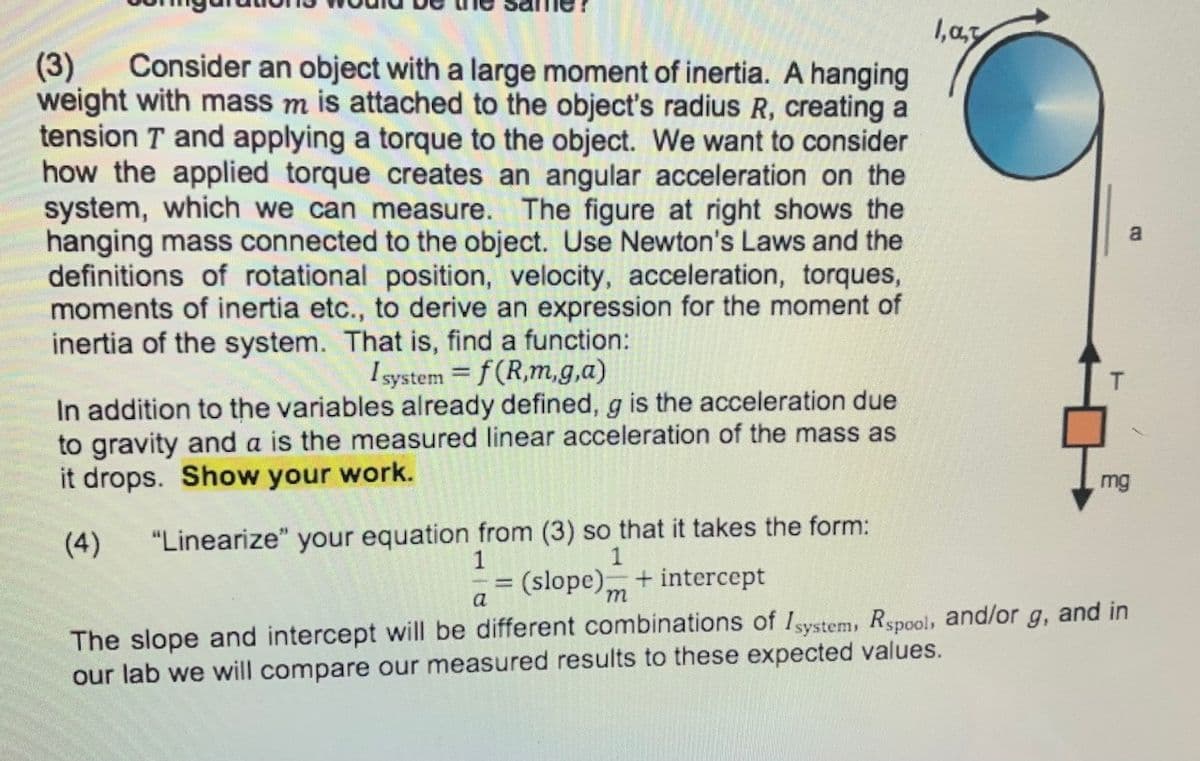Physics for Scientists and Engineers, Technology Update (No access codes included)
9th Edition
ISBN:9781305116399
Author:Raymond A. Serway, John W. Jewett
Publisher:Raymond A. Serway, John W. Jewett
Chapter10: Rotation Of A Rigid Object About A Fixed Axis
Section: Chapter Questions
Problem 10.3OQ: A wheel is rotating about a fixed axis with constant angular acceleration 3 rad/s2. At different...
Related questions
Question
please show all work for question 3.

Transcribed Image Text:1,a7
(3)
Consider an object with a large moment of inertia. A hanging
weight with mass m is attached to the object's radius R, creating a
tension T and applying a torque to the object. We want to consider
how the applied torque creates an angular acceleration on the
system, which we can measure. The figure at right shows the
hanging mass connected to the object. Use Newton's Laws and the
definitions of rotational position, velocity, acceleration, torques,
moments of inertia etc., to derive an expression for the moment of
inertia of the system. That is, find a function:
a
Isystem = f (R,m,g,a)
In addition to the variables already defined, g is the acceleration due
to gravity and a is the measured linear acceleration of the mass as
it drops. Show your work.
mg
(4)
"Linearize" your equation from (3) so that it takes the form:
1
1
(slope)m + intercept
The slope and intercept will be different combinations of Isystem, Rspool, and/or g, and in
our lab we will compare our measured results to these expected values.
Expert Solution
This question has been solved!
Explore an expertly crafted, step-by-step solution for a thorough understanding of key concepts.
Step by step
Solved in 2 steps

Knowledge Booster
Learn more about
Need a deep-dive on the concept behind this application? Look no further. Learn more about this topic, physics and related others by exploring similar questions and additional content below.Recommended textbooks for you

Physics for Scientists and Engineers, Technology …
Physics
ISBN:
9781305116399
Author:
Raymond A. Serway, John W. Jewett
Publisher:
Cengage Learning

Principles of Physics: A Calculus-Based Text
Physics
ISBN:
9781133104261
Author:
Raymond A. Serway, John W. Jewett
Publisher:
Cengage Learning

Glencoe Physics: Principles and Problems, Student…
Physics
ISBN:
9780078807213
Author:
Paul W. Zitzewitz
Publisher:
Glencoe/McGraw-Hill

Physics for Scientists and Engineers, Technology …
Physics
ISBN:
9781305116399
Author:
Raymond A. Serway, John W. Jewett
Publisher:
Cengage Learning

Principles of Physics: A Calculus-Based Text
Physics
ISBN:
9781133104261
Author:
Raymond A. Serway, John W. Jewett
Publisher:
Cengage Learning

Glencoe Physics: Principles and Problems, Student…
Physics
ISBN:
9780078807213
Author:
Paul W. Zitzewitz
Publisher:
Glencoe/McGraw-Hill

College Physics
Physics
ISBN:
9781938168000
Author:
Paul Peter Urone, Roger Hinrichs
Publisher:
OpenStax College

Physics for Scientists and Engineers with Modern …
Physics
ISBN:
9781337553292
Author:
Raymond A. Serway, John W. Jewett
Publisher:
Cengage Learning

University Physics Volume 1
Physics
ISBN:
9781938168277
Author:
William Moebs, Samuel J. Ling, Jeff Sanny
Publisher:
OpenStax - Rice University